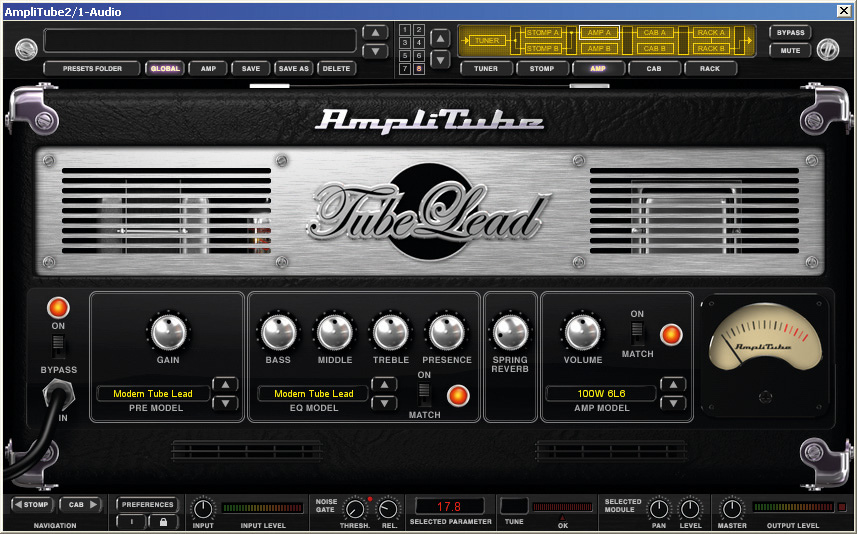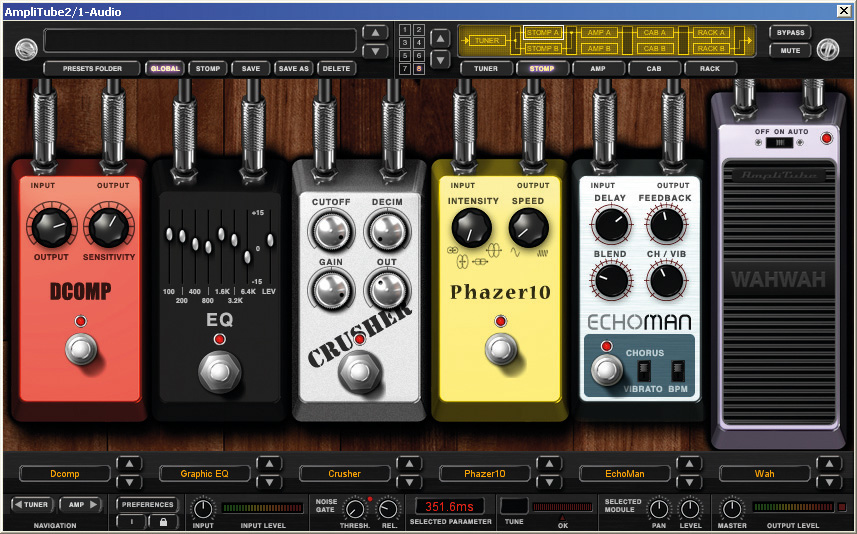MusicRadar Verdict
If you want authentic guitar tones in an easy-to-use plug-in, you can´t go wrong with AmpliTube 2.
Pros
- +
Supremely easy to use. Authentic sounding. Retains natural attack of guitar. Good selection of amps and effects. Nicely balanced presets.
Cons
- -
No internal MIDI control system. No standalone version.
MusicRadar's got your back



Something rather colourful seems to be happening at IK Multimedia of late. Not just in terms of sound, but also graphic design.
Out have gone the rather harsh looking interfaces, knocked aside by smoother, softer and generally nicer anti-aliased screen designs. Such is the case with AmpliTube 2. In fact, so radical is the visual makeover that even die-hard AmpliTube fans would be hard-pushed to recognise the new incarnation of this premier guitar amp simulation package.
So what else is new? Here´s a brief specification summary: 14 preamps, 14 EQ types, seven power amps, 16 cabinets, six microphones, 21 stomp effects and 11 rack effects. Quite a lot to contend with then! What´s interesting about AmpliTube is the way in which you can select the types of preamp, EQ, and power amp independently from each other, instead of them being fixed into a single-amp design as in other software. IK Multimedia point out that - with the 16 cabinet designs - this provides over 20,000 different amplifier combinations. While not all of these combinations will necessarily be particularly unique or interesting, it does illustrate the tremendous degree of flexibility that AmpliTube 2 provides.
Modules
The new tuner, and the separation of amp and cabinet into different modules, brings the number of sound module sections in AmpliTube 2 to five (Tuner, Stomps, Amps, Cabs, FX).Did we say five? Actually, it´s sort of nine, really, since AmpliTube 2 has a ‘split´ facility that doubles up the last four sections, and enables them to be routed in a number of versatile ways to create some amazing sounds.
It´s true that Native Instruments´ Guitar Rig has had splitting capabilities from the outset, but IK Multimedia´s implementation of splits within AmpliTube 2 is much more tightly controlled and less likely to get you tangled up in knots of arcane virtual signal routing. If you want more layers to your sound than this system allows, you can always load up another instance of AmpliTube in a different channel of your host sequencer. In practice, there´s usually more than enough within a single instance of AmpliTube 2 to give you whatever kind of guitar sound you need.
On the stomp-box side of things you get five modulation pedals, two delays, three filter pedals (including wah-wah), three pitch pedals, four distortion pedals, two compressors, an EQ and a volume pedal. These all sound as good as they look, although it has to be said that the graphical display of the volume and wah pedals leaves a little to be desired - you can´t easily tell the positions of the pedals just by looking at them.
The other quirk that´s slightly annoying is the way that the routing of the splits works. Instead of clicking on the relevant part of the routing to change it, you have to choose from one of eight different routing presets. Since there´s no intuitive way of knowing in advance what each preset is, some experimentation is required.
Interface
Apart from the routing selection, the rest of the user interface is so intuitive that we didn´t need to look at the manual at all - operation really is that easy. One big surprise, however, is that there is no direct MIDI control or automation. Instead, all responsibility for remote control of parameters is handed over to your host sequencer.
It´s difficult to judge whether this was a good design decision or not. On the one hand, it does eliminate the potential confusion that´s undoubtedly caused by having two independent yet parallel mechanisms for controlling VST parameters. On the other hand, though, it doesn´t facilitate the delightfully simple ‘click-and-learn´ assignment system that we´re getting used to seeing on other products. Let´s hope that your host sequencer has adequate remote control mapping facilities, then!
IK Multimedia have clearly spent a long time researching the needs of professional guitarists when developing AmpliTube 2; there really isn´t much to complain about here at all. Some of the presets seemed a bit top-heavy with our Strat, but then it´s only natural to expect that they´ll need a certain amount of tweaking in order to suit any particular guitar, since all guitars are, of course, different. On the subject of presets, once again IK Multimedia have resisted the temptation to fill the library with gimmicky, high-impact presets, and instead have supplied a well-chosen selection of genuinely useful tones. Whilst AmpliTube 2 is very straightforward to use, it´s nonetheless a real bonus that a large library of realistic guitar tones has been supplied as a starting point.
The overall experience of using AmpliTube 2 is a very positive one. It doesn´t create tones quite as extreme as the likes of Guitar Rig 2, but for bread-and-butter, classic guitar sounds, AmpliTube 2 definitely has the edge in terms of authenticity. Most importantly, though, the supreme ease-of-use, and complete absence of any confusion during operation deserves a very big thumbs up; anything that makes computer technology easier for guitarists has to be a winner in our books!
MusicRadar is the number 1 website for music makers of all kinds, be they guitarists, drummers, keyboard players, djs or producers...
GEAR: We help musicians find the best gear with top-ranking gear round-ups and high- quality, authoritative reviews by a wide team of highly experienced experts.
TIPS: We also provide tuition, from bite-sized tips to advanced work-outs and guidance from recognised musicians and stars.
STARS: We talk to musicians and stars about their creative processes, and the nuts and bolts of their gear and technique. We give fans an insight into the actual craft of music making that no other music website can.
“Every post feels like a test. If it flops I feel like a failure”: 61% of DJs feel that their social media presence is more important than their skill
“This update reflects everything we believe modern gear should be”: Neural DSP gives the Nano Cortex an almighty power-up with free NanOS 2.0.0 system update
“It’s honestly got me thinking hard about adding one to my own studio set up”: Two Notes Reload II review










